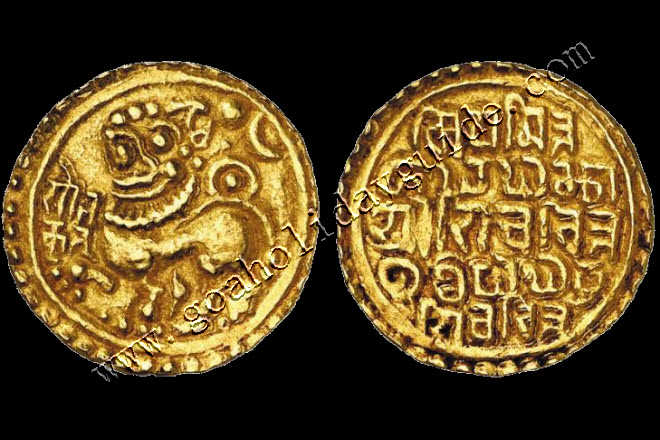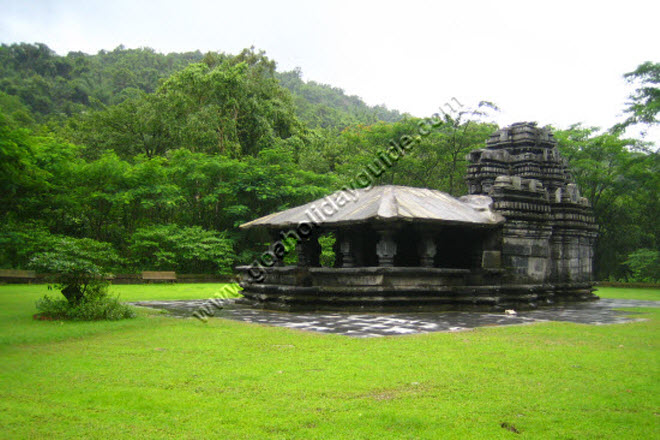Goa Under Kadamba Rule
Kadamba Decline
An internal feud led to the Kadamba King's son to invite, in a letter the Muslim King of Honavar, Jamaluddin to invade Goa. He promised to convert to Islam and marry the Nawab's daughter. Jamaluddin acted swiftly, and sailed with his fleet and mounted an
The Kadambas ruled Goa and South Konkan as the feudatories of the Chalukyas of Kalyani to begin with from 973 A.D. to 1162 A.D, and later on of the Yadavas of Devagiri. Taking advantage of the politically disturbed situation in the Deccan, the Kadambas settled down by the end of the tenth century in the Halshi district f Karnataka, That ceonprised of the southern part of Belgaum.They later moved to the Chandrapura, in Goa, the ancient capital of the Bhojas, on the banks of the Kushavati river.
About the year 1029 A.D. Viravarmadeva appears to have moved the capital to Gopakapattnam, modern Old Goa, on the bans of the river Zuari close to its mouth near the Arabian sea. His brother Jayakeshi I, who ascended the throne after him, organized a strong navy for its defense by sea in 1052. Goa is referred in their records as Govem. An arab merchant Chhadama who commanded the fleet was appointed as the governor of the city. The empire by then had grown poerful and prosperous.
The Decline Of The Kadambas
In 1312 A.D emperor Alludin Khilji of Delhi sent an army under his general Malik Kafur, which laid waste to all areas south of the Vindhyas including the Konkans. In 1327 A.D emperor Mohammed bin Tughlak brought under his control distant provinces along the Western cost bordering the Arabian sea. It might be probable that Gopakapatnam might have bene destroyed during the invasion in 1312 A.D. The capita was shifted back to Chandrpur which was located on the upper reaches of the Zuari and strategically more defendable. The Kadamba ruler Kamadeva, brother in law of Shastadeva II might have been killed in the battle of Gopakapattan. His grandson went on to reestablish himself at Chandrapur.
The Muslim inaders of Tughluq devastated it in 1327 as is evidenced from the large number of copper coins from the Tughluq dynasty in Chandor. The memory of the tragedy that befell the city lindgers on in the consciousness of the people in the form of legend and beliefs related to it. It is possible that Kamadeva's son rebuilt Goa and Gopakapattnam after the return of the muslims to Delhi as the Capital was once again moved to Gopakataam.
The grandson of Kamadeva, might be the king Bhiravarma known through a veergall (hero stone), now lying in the archeological museum in Old Goa, ruling at the time of the attack of the nawab of Honawar on Goakapattnam. This hero stone commemorates the death of Bhiravarma's feudatory chief, who reportedly died in a sea battle.
Ibn Batuta's Description of Goa
Ibn Batuta, the famous Arab traveller visited Goa during the time of the Kadambas and infact, witnessed the battle that brough the downfall of the Kadambas. Ibn Batuta graphically describes the battle in question to which he was himself a witness. Below is an excerpt from his travels...
"At this time the king was preparing an expedition against the island of Sindabur. For this purpose he had prepared two and fifty vessels, which when ready he ordered me to attend for the expedition." "When we got to the island of Sindabur, we found the people ready to resist us and a hard battle was fought. We carried the place however by divine permission by assault. After this the king game me a slave girl with clothing and other necessities."
Ibn Batuta described the kingdom of Chandrapur as a kingdom on an island of thirty six villages, in the center of which lie two cities, One built by the Infidels (Hindus) and the orther by Muslims, referrences made to Gopakapatnam obviously which would have been captured. He describes Goa again during the Kadamba seige of Gopakapattam when the Kadambas tried to take back their former capital as follows...
"I then returned to Sindabur to the King Jamaluddin, at the time of which an infidel king was besieging the town with his troops, I left the place, therefore, and made for the Maldive Islands, at which after 10 days I arrived."

